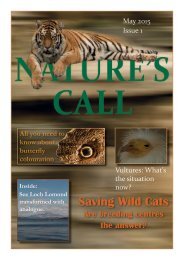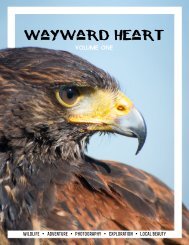ANIMAL
Create successful ePaper yourself
Turn your PDF publications into a flip-book with our unique Google optimized e-Paper software.
BIRD<br />
BIRD<br />
LANNER<br />
THE LANNER FALCON IS A HANDSOME AND POWER-<br />
FUL BIRD OF PREY, WITH GREY-BROWN TO SLATY<br />
UNDERPARTS, A CREAMY WHITE THROAT AND<br />
UNDERPARTS, SOMETIMES WITH THE DARK SPOTS<br />
OR STRIPPING AND A CHARACTERISTIC RED-<br />
DISH-BROWN CROWN ON THE HEAD<br />
SAKER<br />
THE SAKER CAN BE CATEGORIES AS A BIG AND STRONG FALCON.<br />
IT LARGER THAN LANNER AND IT HAS VERY<br />
WIDE WINGSPAN FOR ITS SIZE.<br />
Sometimes, people miss looks at them and thought is a Peregrine Falcon<br />
because of they has same size but the different is body colour. Lanners are divided<br />
into Feldeggi breed in Europe and Erlangeri breed in North Africa. The latter is<br />
a bit smaller with less spotted and paler underparts and a darker grey back.<br />
During juveniles, both breeds are much slimmer with brownish back and dark<br />
streaked underparts. Lanner falcons live on African seashores as well as in continenetals<br />
areas, from Mauritius to Egypt. It can be found also in Italy, at Balkan<br />
Peninsula, Turkey and small part of Asia. In Africa, we can found the nest in semi<br />
desert areas of Moroccan Atlas until Lybia and around dry Savannah. In Europe,<br />
They live in rocky areas with steep cliffs and also on littoral cliffs.<br />
Lanner live in pairs but when comeout for hunting, they will do in group.<br />
During hunting, female will acts like a beater and hunt out the victims while the<br />
male remains a bit behind, ready to pounce down on the prey. This is quite rare<br />
technics among the birds of prey but it can give them enough food to survive.<br />
During hunting and flying, Lanner can be considered as one of the fastest falcon<br />
during flying.<br />
Usually, lanners don’t build their nest for breeding. They like to reused corvidae’s<br />
old nest or diurnal birds of prey abandoned eyries. We can found the nest<br />
on a ledge, at sheer promontory or a tree. Female lays 2-5 eggs between February<br />
and March. Both of male and female will look around fro the eggs and normally<br />
the youngs will fledge after 40 days after hatching.<br />
The Saker can be categories as a big and strong falcon. it larger than<br />
Lanner and it has very wide wingspan for its size. The Saker has a large range of<br />
colour from dark brown to grey and almost white. Saker also can breed with gyrfalcons<br />
and form a hybrid falcon. The saker originally coming from southeast<br />
Europe and Asia. They can be found at open plains and forest steppes. They can<br />
be found on the steppes of Mongolia, southern Siberia and around Russian Altai<br />
mountains.<br />
They spent most of their time hunting for mammals like rats, stoats, weasel,<br />
Siberian chipmunks and birds. They dive fir their prey at 200mph. The Saker<br />
falcons are aggressive hunter and often attack bigger prey than them. But normally<br />
the female are more furious than male.<br />
The Saker Falcon is the favorite bird among Arab Falconers. Many of the<br />
birds are trapped in Arab countries when they are on the way to migration to<br />
Middle East. They are being most favorite because it will help the falconers to<br />
captured juvenile female sakers and train them to hunt because it’s easier to train<br />
compare with adult. Sakers always be a target and caught over Asia Region and<br />
sold to the Middle East falcon market. Without breeding, the sakers population is<br />
in dangers of declining.<br />
At the moment, there is no accurate figures how many saker falcons left,<br />
but it is believed that there are getting extinct. Hopefully in the future our next<br />
generations still have a chance to see the furious saker flying around.














